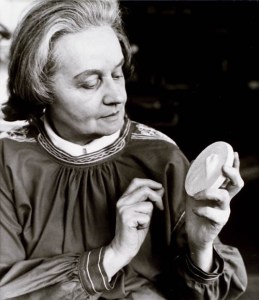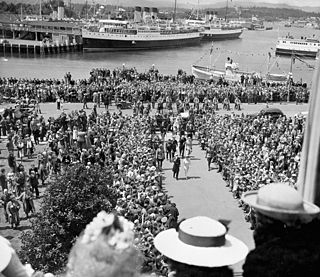Related Research Articles

The Royal Canadian Mint is the mint of Canada and a Crown corporation, operating under the Royal Canadian Mint Act. The shares of the Mint are held in trust for the Crown in right of Canada.

The Canadian fifty-cent coin is a Canadian coin worth 50 cents. The coin's reverse depicts the coat of arms of Canada. At the opening ceremonies for the Ottawa branch of the Royal Mint, held on January 2, 1908, Governor General Earl Grey struck the Dominion of Canada's first domestically produced coin. It was a silver fifty-cent coin bearing the effigy of King Edward VII.
James E. Charlton was a Canadian coin dealer and numismatic publisher.
The Charlton Press is a book publishing company that produces pricing guides as well as other books on related topics, including collectibles and porcelain figures. The company's first title was Catalogue of Canadian Coins, Tokens & Fractional Currency, published in 1952, and contained all coins used as circulating tender in Canada from 1858 until present.
One of the most profitable aspects of the Royal Canadian Mint (RCM) is its numismatic product line. The first numismatic coin from the RCM was arguably the 1935 dollar commemorating the Silver Jubilee of His Majesty King George V. Though intended for circulation, it was the first Canadian coin commemorating an event. The decision to issue this coin was made in October 1934 by then-Prime Minister R.B. Bennett. There were economic and patriotic motivations for the release of a silver dollar, including a hope to boost the silver mining industry. In future years, the silver dollar would have a more emotional meaning for many Canadians because it was also the first coin to have the Voyageur motif on its reverse.
By 1954, a new trend was beginning to emerge for the Royal Canadian Numismatic Association as annual meetings evolved into annual conventions. Working with the Toronto Coin Club as host, the first such convention was held in Toronto in 1954. The conventions offered an agenda of educational forums, bourse activity, competitive exhibits with awards to the winners, and a closing banquet, with the highlight being a special guest speaker.. It was also in 1954 that the association issued its first ever medal to commemorate the event. The tradition of an annual convention and a convention medal continues to this very day.
The Canadian silver dollar was first issued by the Royal Canadian Mint in 1935 to commemorate the Silver Jubilee of King George V. The coin's reverse design was sculpted by Emanuel Hahn and portrays a voyageur and a person of Indigenous descent paddling a birch-bark canoe. The faint lines in the background represent the Northern Lights. The voyageur design was used on the dollar until 1986. It was then replaced with the 1987 Canadian 1-dollar coin. 1967 marked the end of the silver dollar as a business strike, or a coin issued for circulation. After 1967, the dollar coin was made of nickel, except for non-circulating commemorative issues for the collector market, which continue to contain silver.
Jerome "Jerry" Hosmer Remick III was a Canadian numismatist, geologist and columnist for Canadian Coin News.
One of the most highly profitable aspects of the Royal Canadian Mint's enterprise is in its Numismatic product line. The euphoria surrounding the year 2000 led to the birth of the Millennium 25-cent coin program. The numismatic line included proof quality coins sold individually or as a complete set. This level of excess would come to signify the coming decade. The number of numismatic releases would increase on an annual basis starting in 2003. Numismatic three cents, five cents, and ten cents would be introduced, along with numismatic three dollars and eight dollars. Luxury coins would not be immune to the dramatic increases that ensued. Coins with face values of 250, 300 and 350 dollars would be introduced by 2006.
The Canadian Paper Money Society (CPMS) is a non-profit numismatic organization for collectors of Canadian paper money, including government and private bank issues, municipal scrip, stocks, bonds, and other forms of payment. It has members throughout Canada, the United States and in other countries.
The Royal Canadian Mint has made coins with various themes. Most recently, ice hockey has been used for many numismatic releases. The first known ice hockey coin was for the 1988 Winter Olympics. Issued on February 25, 1986, the coin featured a goalie on the coin. Edge lettering was also used for the coin, the first time that it was used on silver coins.
Yvon Gariepy was the President of the Royal Canadian Mint from 1975 to 1981. In later years, he worked for Canada Post. Mr. Gariepy was a professional member of the Order of Engineers of Quebec, Professional Corporation of Urbanists of Quebec, Canadian Institute of Planners and the Institute of the Public Administration of Canada.
Starting in 1997, the Royal Canadian Mint started to sell hockey medallions to the public. To commemorate the induction of Mario Lemieux in the Hockey Hall of Fame, a set was issued honouring all three inductees. One set was issued in Sterling Silver while another was issued in Nickel. The success of the release led to future issues.

Dora de Pédery-Hunt, LL.D. was a Hungarian-Canadian sculptor who designed medals and coins. She was the first Canadian citizen to design an effigy for Queen Elizabeth II.

Royal tours of Canada by the Canadian royal family have been taking place since 1786—when the future King William IV became the first member of the royal family to visit Canada—and continue into the 21st century, either as an official tour, a working tour, a vacation, or a period of military service by a member of the royal family. In 1939, King George VI became the first reigning monarch to tour the country.

Canadian roller derby leagues at one point were welcomed to join the Canadian Women's Flat Track Roller Derby Association, which in January 2012 renamed itself the Roller Derby Association of Canada. The Toronto Roller Derby League is the largest flat-track derby league in Canada. Many roller derby leagues enjoy support from their national skate federations, including Roller Sports Canada.
Numismatic associations bring together groups of numismatists. They may be commercial, hobby or professional. Membership is sometimes by election.

Stanley Witten is a Canadian artist and engraver. Witten has received national recognition in Canada for his coin designs, including Big Maple Leaf in 2003, and the Terry Fox loonie in 2005.
References
- ↑ "Jerry Remick: 1928-2005", p.14, Canadian Coin News, Volume 42, Number 25, April 5 to 18, 2005, Trajan Publishing
- ↑ Canadian Coin News, August 19 to September 1, 2008, p.1, "CNA becomes Royal" by Mario Cywinski
- ↑ Canadian Numismatic Journal, Jul-Aug 2023, p.196.
- 1 2 R.C.N.A. | Royal Canadian Numismatic Correspondence Course - Part II
- 1 2 3 C.N.A. | Fellow of the R.C.N.A. Award
- ↑ Canadian Coin News, August 19 to September 1, 2008, p.26, “Award galore at RCNA's annual banquet” by Bret Evans
- 1 2 3 4 Canadian Numismatic Journal, September 2013, Vol 58 No 7, p 393, “2013 Literary and Special Awards”
- 1 2 Canadian Coin News, August 19 to September 1, 2008, p.26, "Fiocca award winner announced" by Bret Evans
- Royal Canadian Numismatic Association Official site.